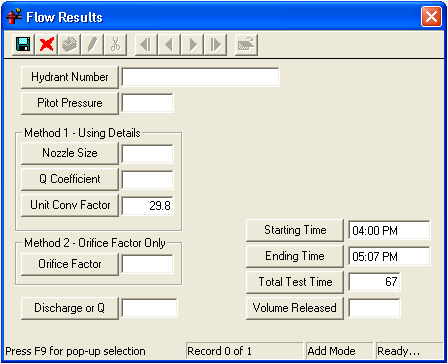
Note: The hydrant class you selected in the Residual hydrant record (i.e. the main record) will determine what hydrants are available in the pick list.
Note: This field must be populated for the Discharge or Q to be calculated.
Note: If you know the orifice factor, skip ahead to step 5.
Note: The Unit Conv Factor field defaults to 29.8 SAE (0.111 SI); however, you can modify this number. All three of these fields must be populated for the Discharge or Q field to be calculated. The Discharge or Q will then be calculated as follows:
Discharge = Unit Conv Factor * Q coefficient * (nozzle size)2 * square root of Pitot Pressure reading
Discharge = Orifice Factor * square root of Pitot Pressure reading
Volume Released = Discharge * Total Test Time
 to save the record.
to save the record. to close the window.
to close the window.